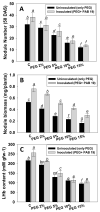Drought Tolerant Enterobacter sp./ Leclercia adecarboxylata Secretes Indole-3-acetic Acid and Other Biomolecules and Enhances the Biological Attributes of Vigna radiata (L.) R. Wilczek in Water Deficit Conditions
- PMID: 34827142
- PMCID: PMC8614786
- DOI: 10.3390/biology10111149
Drought Tolerant Enterobacter sp./ Leclercia adecarboxylata Secretes Indole-3-acetic Acid and Other Biomolecules and Enhances the Biological Attributes of Vigna radiata (L.) R. Wilczek in Water Deficit Conditions
Abstract
Drought or water stress is a limiting factor that hampers the growth and yield of edible crops. Drought-tolerant plant growth-promoting rhizobacteria (PGPR) can mitigate water stress in crops by synthesizing multiple bioactive molecules. Here, strain PAB19 recovered from rhizospheric soil was biochemically and molecularly characterized, and identified as Enterobacter sp./Leclercia adecarboxylata (MT672579.1). Strain PAB19 tolerated an exceptionally high level of drought (18% PEG-6000) and produced indole-3-acetic acid (176.2 ± 5.6 µg mL-1), ACC deaminase (56.6 ± 5.0 µg mL-1), salicylic acid (42.5 ± 3.0 µg mL-1), 2,3-dihydroxy benzoic acid (DHBA) (44.3 ± 2.3 µg mL-1), exopolysaccharide (204 ± 14.7 µg mL-1), alginate (82.3 ± 6.5 µg mL-1), and solubilized tricalcium phosphate (98.3 ± 3.5 µg mL-1), in the presence of 15% polyethylene glycol. Furthermore, strain PAB19 alleviated water stress and significantly (p ≤ 0.05) improved the overall growth and biochemical attributes of Vigna radiata (L.) R. Wilczek. For instance, at 2% PEG stress, PAB19 inoculation maximally increased germination, root dry biomass, leaf carotenoid content, nodule biomass, leghaemoglobin (LHb) content, leaf water potential (ΨL), membrane stability index (MSI), and pod yield by 10%, 7%, 14%, 38%, 9%, 17%, 11%, and 11%, respectively, over un-inoculated plants. Additionally, PAB19 inoculation reduced two stressor metabolites, proline and malondialdehyde, and antioxidant enzymes (POD, SOD, CAT, and GR) levels in V. radiata foliage in water stress conditions. Following inoculation of strain PAB19 with 15% PEG in soil, stomatal conductance, intercellular CO2 concentration, transpiration rate, water vapor deficit, intrinsic water use efficiency, and photosynthetic rate were significantly improved by 12%, 8%, 42%, 10%, 9% and 16%, respectively. Rhizospheric CFU counts of PAB19 were 2.33 and 2.11 log CFU g-1 after treatment with 15% PEG solution and 8.46 and 6.67 log CFU g-1 for untreated controls at 40 and 80 DAS, respectively. Conclusively, this study suggests the potential of Enterobacter sp./L. adecarboxylata PAB19 to alleviate water stress by improving the biological and biochemical features and of V. radiata under water-deficit conditions.
Keywords: Enterobacter sp./L. adecarboxylata; Vigna radiata (L.) R. Wilczek; drought stress; gas exchange parameters; growth improvement; growth regulating substances.
Conflict of interest statement
The authors declare no conflict of interest.
Figures








References
-
- Shahid M., Ahmed B., Khan M.S. Evaluation of microbiological management strategy of herbicide toxicity to greengram plants. Biocatal. Agric. Biotechnol. 2018;14:96–108. doi: 10.1016/j.bcab.2018.02.009. - DOI
-
- Bartholomeus R.P., Witte J.M., van Bodegom P.M., van Dam J.C., Aerts R. Climate change threatens endangered plant species by stronger and interacting water-related stresses. J. Geophys. Res. Biogeosci. 2011;116:G04023. doi: 10.1029/2011JG001693. - DOI
Grants and funding
LinkOut - more resources
Full Text Sources
Molecular Biology Databases
Miscellaneous

